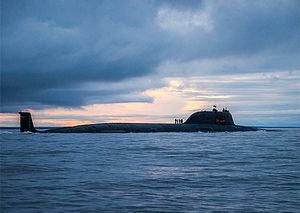The Russian Navy’s first Project 885-M Yasen M-class multipurpose nuclear-powered attack/cruise missile submarine (SSN/SSGN), christened Kazan, will be begin state trials and live firing tests in the summer of 2019, according to a Russian shipbuilding industry source.
“In summer 2019, the submarine should embark on state trials and test-fire Oniks and Kalibr missiles at surface and coastal targets in autumn,” the source told TASS news agency on December 7. “The new submarine is expected to enter service with the Northern Fleet in late 2019.”
The Kazan was launched at the Sevmash shipyards in Severodvinsk, a port city on Russia’s White Sea in Arkhangelsk Oblast, in March 2017. The boat has been construction at the Sevmash shipyards since 2009 and is the first is the second overall Yasen-class SSN launched by the Russian shipbuilding industry and the first upgraded Yasen M-class submarine. The Kazan embarked on its first set of factory and underwater sea trials in September.
There are currently five Yasen M-class SSN in various stages of construction. Yet, only one Yasen-class SSN, the K-329 Severodvinsk, which took almost 18 years to build, has so far been commissioned into service. Notably, there is reason to believe that only two more Yasen M-class boats will be completed given the Russian Navy’s depleted budget.
The improved Yasen M-class SSN is reportedly quieter than the lead Yasen-class boat. It is built with low magnetic steel to reduce its magnetic signature. The Yasen M-class SSN is purportedly not equal to the United States Navy’s new Virginia-class attack subs. Rather it is technically on par with older U.S. Seawolf-class SSNs, built by the U.S. Navy from 1989 to 2005, although the underwater top speed of the Russian subs is reportedly much lower than that of U.S. boats.
The Kazan is fitted with eight vertical СМ-346 complex (3Р-14В) silos for submarine-launched cruise missiles as well as ten torpedo tubes for firing the 3M-54 Kalibr supersonic cruise missile, the P-800 Onik over-the-horizon supersonic anti-ship missile, and an improved variant of the 533-millimeter Fizik-1 homing torpedo. The Severodvinsk can carry up to 40 Kalibr cruise missiles while the second, Kazan, can carry 32. (The Kazan is approximately 10-12 meters shorter than the first boat.)
The Yasen-class boats are among the most expensive submarines ever to be built in Russia. As I noted elsewhere:
The 13,800-ton, 390-foot long and highly automated Yasen-class of Russian attack submarines was supposed to replace older Soviet-era multi-purpose nuclear submarine models by 2020.
Yet, the exorbitant costs of the submarines — estimated to be twice as much as the new Borei-class SSBNs – has so far led only to the commissioning of one out of eight SSNs (…).
One of the reasons for the excessive costs is untried new technology installed aboard the Yasen M-class. For example, Yasen M boats are allegedly equipped with a new spherical sonar, dubbed MGK-600 Irtysh-Amfora, and a new fourth-generation nuclear reactor (…)
The Yasen-class SSN will likely prove a formidable adversary and will constitute a genuine threat to U.S. boomers and carrier strike groups in the years ahead.
































